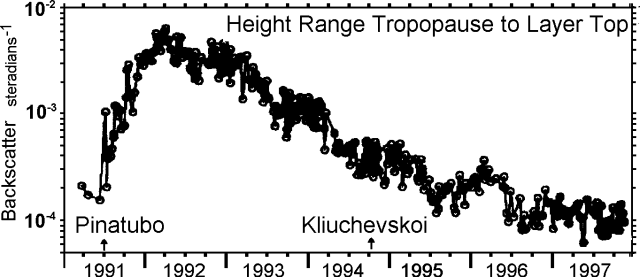Report on Atmospheric Effects (1995-2001) — March 1998

Atmospheric Effects (1995-2001)
Bulletin of the Global Volcanism Network, vol. 23, no. 3 (March 1998)
Managing Editor: Richard Wunderman.
Atmospheric Effects (1995-2001) Lidar data from Germany and Virginia
Please cite this report as:
Global Volcanism Program, 1998. Report on Atmospheric Effects (1995-2001) (Wunderman, R., ed.). Bulletin of the Global Volcanism Network, 23:3. Smithsonian Institution.
Atmospheric Effects (1995-2001)
All times are local (unless otherwise noted)
Table 13 lists atmospheric lidar data from Hampton, Virginia for 8 April 1997 through 26 February 1998, and from Garmisch-Partenkirchen, Germany for 3 November 1997 to 14 April 1998. The aerosol backscatter measured at Hampton on 26 February 1998 shows a typical winter increase in stratospheric aerosol compared to measurements made the previous summer. The increase from summer to winter is generally a function of the difference in tropopause height between the two seasons. In this case there is a significant decrease in integrated stratospheric aerosol compared to measurements obtained during the winter of 1997 (Bulletin v. 22, nos. 1, 3).
Table 13. Lidar data collected for Virginia (April 1997-February 1998) and Germany (November 1997-April 1998) showing altitudes of aerosol layers. Backscattering rations from Hampton are for the ruby wavelength of 0.69 µm; those from Garmisch-Partenkirchen are for the Nd-YAG wavelength of 0.53 µm, with equivalent ruby values in parentheses. The integrated value shows total backscatter, expressed in steradians-1, integrated over 300-m intervals from the tropopause to 30 km for both Virginia and Germany. Courtesy of Mary Osborne and Horst Jäger.
| DATE | LAYER ALTITUDE (km) (peak) | BACKSCATTERING RATIO | BACKSCATTERING INTEGRATED |
| Hampton, Virginia (37.1°N, 76.3°W) | |||
| 08 Apr 1997 | 17-27 (20.5) | 1.12 | 5.02 x 10-5 |
| 16 Apr 1997 | 17-27 (19.6) | 1.17 | 6.90 x 10-5 |
| 07 May 1997 | 17-27 (20.3) | 1.14 | 4.90 x 10-5 |
| 22 May 1997 | 15-28 (20.5) | 1.13 | 4.76 x 10-5 |
| 11 Jun 1997 | 15-25 (20.6) | 1.12 | 3.01 x 10-5 |
| 15 Jul 1997 | 15-27 (18.1) | 1.14 | 3.73 x 10-5 |
| 01 Aug 1997 | 15-28 (23.6) | 1.11 | 3.53 x 10-5 |
| 05 Sep 1997 | 14-30 (21.7) | 1.11 | 4.06 x 10-5 |
| 26 Feb 1998 | 12-28 (16.4) | 1.10 | 4.28 x 10-5 |
| Garmisch-Partenkirchen, Germany (47.5°N, 11.0°E) | |||
| 03 Nov 1997 | 13-26 (17.4) | 1.07 (1.13) | -- |
| 08 Nov 1997 | 10-26 (19.9) | 1.06 (1.13) | -- |
| 10 Nov 1997 | 9-25 (18.9) | 1.08 (1.15) | -- |
| 19 Nov 1997 | 10-24 (20.3) | 1.06 (1.12) | -- |
| 27 Nov 1997 | 10-23 (16.0) | 1.07 (1.13) | -- |
| 09 Jan 1998 | 10-26 (21.9) | 1.08 (1.15) | -- |
| 30 Jan 1998 | 11-28 (14.7) | 1.07 (1.13) | -- |
| 13 Feb 1998 | 12-30 (18.1) | 1.08 (1.16) | -- |
| 18 Feb 1998 | 12-27 (18.3) | 1.09 (1.18) | -- |
| 10 Mar 1998 | 11-33 (17.3) | 1.10 (1.20) | -- |
| 25 Mar 1998 | 10-28 (17.0) | 1.05 (1.09) | -- |
| 14 Apr 1998 | 11-32 (16.3) | 1.07 (1.13) | -- |
A graph of integral stratospheric aerosol backscatter (figure 5) shows how the stratospheric aerosol load had declined by the end of 1997 to pre-Pinatubo values. More observations are needed to decide whether a new background level has been reached or will be reached in the near future.
Information Contacts: Mary Osborn, NASA Langley Research Center (LaRC), Hampton, VA 23665 USA; Horst Jäger, Fraunhofer -- Institut für Atmosphärische Umweltforschung, Kreuzeckbahnstrasse 19, D-82467 Garmisch-Partenkirchen, Germany.

